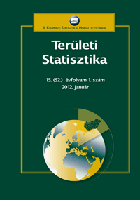Térségi sokszínűség és stabilitás: az iskolázottság települési szintű egyenlőtlenségeinek változása Magyarországon 1990–2011 között
Regional Diversity and Stability: Changes in the Inequalities of Education at Settlement Level in Hungary between 1990 and 2011
Author(s): János Pénzes, János Péter Kiss, Attila Deák, Norbert ApátiSubject(s): Social Sciences, Economy, Geography, Regional studies
Published by: Központi Statisztikai Hivatal
Keywords: Gini index; education; peripheral areas; spatial autocorrelation; regional inequalities; Williamson hypothesis
Summary/Abstract: Education is one of the most important factors of territorial development; therefore, it is worth following its inequality tendencies. After the political transition in Hungary, the several-decade long trend of declining inequalities slowed down, but from the turn of the millennium, the regional inequalities of education decreased again, which raise some – partly methodological– dilemmas. In this study, data on the level of education, the average finished school years ofthe Hungarian population are analysed for 1990,2001 and 2011, based on census data. The results demonstrate that changes in this indicator compared with the national average without Budapest (fit, overall, in the formation of the spatial structure of the country after the political transition, and) have resulted in a higher level of education. Nevertheless, there are relative losers and winners of this process. The winner areas include the agglomerations of Budapest and the largest towns, North Western Transdanubia as well as the surroundings of Lake Balaton; the loser areas comprise the territories affected by the industrial structural crisis and the traditional peripheral zones. The inner-district inequalities call attention to the differing paths of regions. Peripheral areas are characterised by higher level of inequalities and a divergent process, while developed districts with more favourable educational values can be described by lower level of inequalities and dominant convergence. This relation proves the relevanceof Williamson’s inverted U curve hypothesisin income conditions (Németh–Kiss 2007) and in the level of education. The current analyses highlight that in terms of some of the educational indicators the stable backwardness and increasing falling behind of the peripheral areas continued after the political transition.
Journal: Területi Statisztika
- Issue Year: 58/2018
- Issue No: 06
- Page Range: 567-594
- Page Count: 28
- Language: Hungarian

